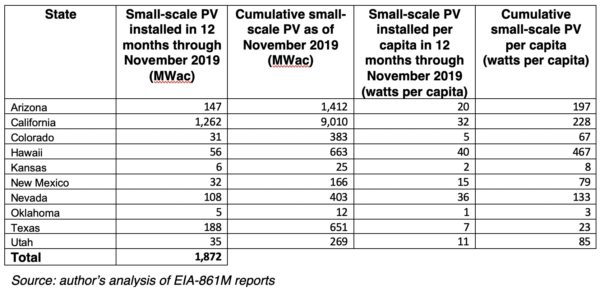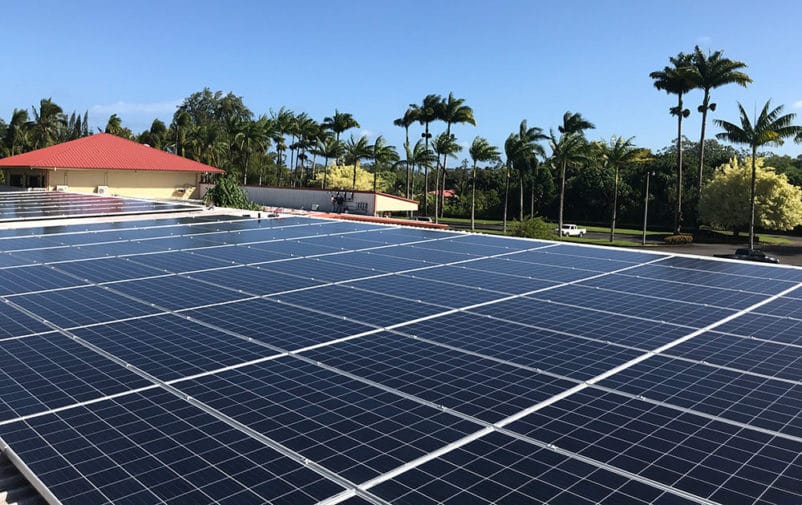The ten states with the greatest solar resources added 1,872 MW of small-scale solar in the 12 months ending in November, 2019—slightly more than in 2018. California punched above its weight, adding two-thirds of the total, although it has only 40% of the region’s population.
Rooftop solar installations account for most small-scale solar, which is defined as smaller than 1 MW.
Hawaii extended its commanding lead in cumulative small-scale solar per capita, with California in second place and Arizona a close third. Overall, six of the ten states exceed the national average of 69 watts of small-scale solar per capita. A complete state scorecard is below.
Policy goals
Here are solar advocacy groups’ 2020 policy goals for distributed solar, starting with Hawaii and California.
Hawaii: Noting Hawaii’s renewables mandate, Will Giese, executive director of Hawaii Solar Energy Association, a SEIA state affiliate, presented this vision:
“Currently, there is a lack of proper value streams to allow customers [an] incentive to adopt energy storage or demand response technology. The battle to get to 100% by 2045 will be won or lost behind the meter, through distributed energy resources like PV-plus-storage. We know that distributed energy resources create value for all ratepayers, and we’ve seen that in average electric bill reduction from 2011 to 2018 in Hawaii, despite electric rates remaining the same. It’s time to put that value on paper, and get to building the distribution-up grid we’re always talking about.”
Turning to specifics, Giese said, “All of the functionality of advanced inverters and energy storage is lost if customers don’t have a price signal or incentive to turn it on or use it when it’s most needed.” He projected that “Hawaii will likely be one of the first states to develop a time-based rate structure with [compensation for] grid services.”
California: The Solar Energy Industries Association (SEIA) will advocate for electricity rates that support the growth of rooftop solar and storage, said Rick Umoff, California senior director and counsel for SEIA, as the organization engages in six utility rate cases this year.
California will also review its net energy metering policy this year, and SEIA will advocate for “a fair rate structure that recognizes the various benefits that solar provides,” Umoff said, adding that SEIA wants to ensure that customers who add solar-plus-storage “are fully credited for the resilience benefits their systems provide.”
SEIA will also work “to ensure the industry continues to grow responsibly, by developing robust and balanced consumer protection regulations that allow more customers to go solar,” Umoff said.
Arizona: Noting that the utility Arizona Public Service has set a goal of 45% renewable energy by 2030 and 100% clean energy by 2045, Vote Solar is asking the Arizona Corporation Commission (ACC) to “turn one, voluntary commitment into a statewide mandate, with a minimum of 10% from local, customer-owned solar installations,” said Art Terrazas, the group’s Interior West director.
Similarly, Solar United Neighbors (SUN) is calling for the ACC to set a “binding 50% renewable energy standard” by 2030, with a 10% carve-out for distributed resources such as solar, said Bret Fanshaw, the group’s Arizona program director. Unlike other states, where the state legislature may set a renewable portfolio standard, Arizona’s constitution “empowers [the ACC] to regulate utilities,” and “the ability to set renewable energy targets is included in this mandate,” explained Ben Delman, communications director for SUN.
SEIA is “looking to see whether [Arizona Public Service’s] newfound commitment to renewable energy also applies to behind-the-meter solar systems,” said Sara Birmingham, SEIA’s senior director of state affairs, adding that SEIA will seek to “limit the decline of the solar export credit.”
New Mexico: Vote Solar is “supporting the Community Solar Act again this year,” said Marta Tomic, the group’s Interior West senior director. She notes that the bill would reserve 30% of new community solar capacity for projects serving low-income customers.
Utah: SEIA is “focused on maintaining an export rate for residential rooftop solar that will be sufficient to maintain the market,” in a proceeding before the Public Service Commission, said Sara Birmingham of SEIA.
1.6 GW more in other states
Last year, solar contractors in the Southeast added 427 MW of small-scale solar; those in the Northeast added 800 MW; and those in 19 Midwest and Northern Tier states added 400 MW.
State scorecard
Here’s the scorecard for the ten sunniest states, based on data from the U.S. Energy Information Administration’s Form EIA-861M data:

EIA does not collect data on all distributed solar installations, which are defined as those not directly connected to the bulk transmission system, and which can range much larger than 1 MW.
This content is protected by copyright and may not be reused. If you want to cooperate with us and would like to reuse some of our content, please contact: editors@pv-magazine.com.








By submitting this form you agree to pv magazine using your data for the purposes of publishing your comment.
Your personal data will only be disclosed or otherwise transmitted to third parties for the purposes of spam filtering or if this is necessary for technical maintenance of the website. Any other transfer to third parties will not take place unless this is justified on the basis of applicable data protection regulations or if pv magazine is legally obliged to do so.
You may revoke this consent at any time with effect for the future, in which case your personal data will be deleted immediately. Otherwise, your data will be deleted if pv magazine has processed your request or the purpose of data storage is fulfilled.
Further information on data privacy can be found in our Data Protection Policy.